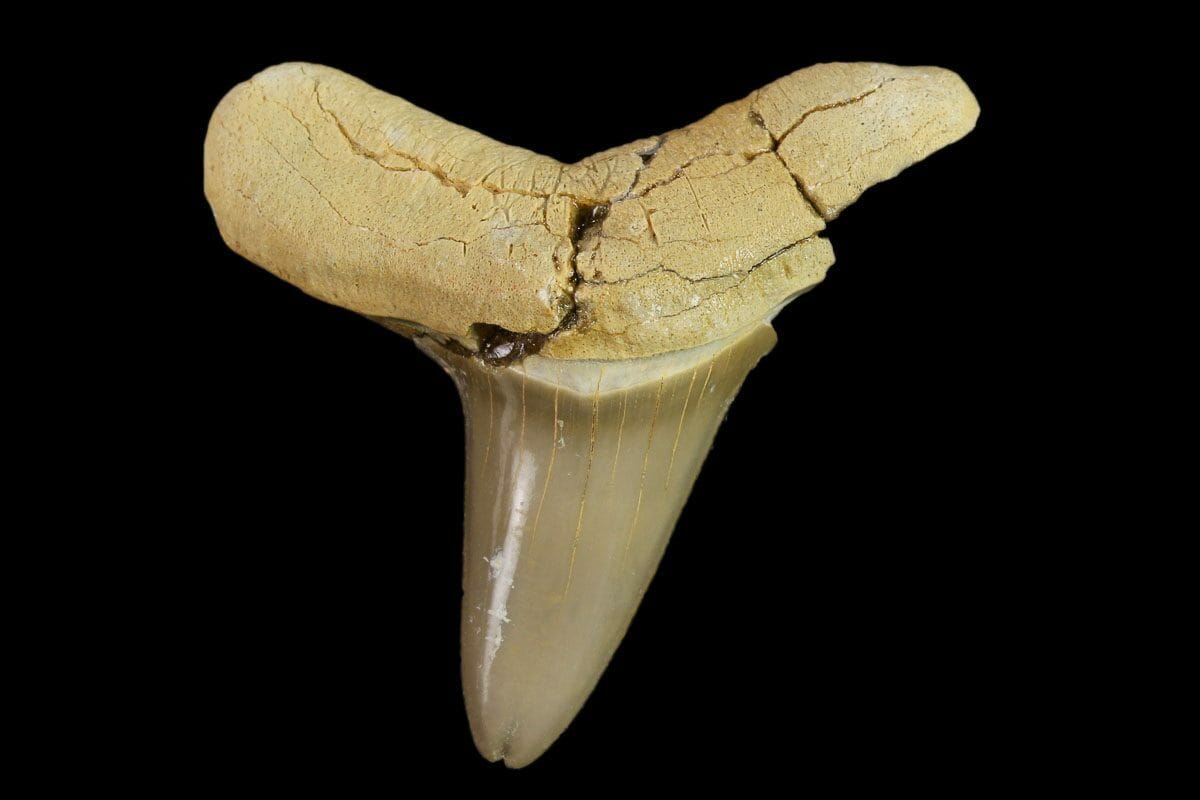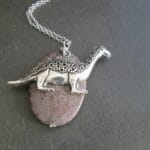Dive into the prehistoric world of the Cretoxyrhina, a massive shark nicknamed the “Ginsu Shark” for its razor-sharp teeth. This apex predator ruled the oceans during the Late Cretaceous period, some 100 to 73 million years ago. Explore its impressive size, formidable hunting tactics, global reach, and the mysteries surrounding its eventual disappearance.
A Prehistoric Powerhouse
First discovered in 1822, Cretoxyrhina’s fossilized remains captivated scientists. This ancient shark, estimated to be about 23 feet long, rivaled even the Tyrannosaurus Rex in size. But what truly set it apart were its jaws. Armed with rows of serrated teeth, much like a Ginsu knife, Cretoxyrhina could deliver a powerful bite—scientists suggest a force of over 5,000 pounds—capable of crushing bone and tearing flesh with ease.
Built for the Hunt
Beyond its size and bite, this prehistoric predator possessed a streamlined, torpedo-like body, allowing it to move through the water with impressive speed and agility. This swiftness made Cretoxyrhina a formidable hunter of the deep.
Unveiling the Ginsu Shark’s Diet
Cretoxyrhina was an opportunistic feeder, earning it the nickname “Predator X” amongst scientists. Fossil evidence suggests a diverse diet, including:
- Giant Sea Reptiles: Fossils reveal encounters with large marine reptiles like plesiosaurs and even evidence of attacks on mosasaurs.
- Large Fish: Xiphactinus, a large bony fish from the same period, was likely a common prey item for Cretoxyrhina.
- Other Sharks: Bite marks on shark fossils suggest that Cretoxyrhina may have engaged in scavenging or even hunted other shark species.
- Dinosaurs: While not its primary food source, there’s evidence suggesting that Cretoxyrhina may have scavenged on dinosaurs that strayed too close to the water’s edge.
- Cephalopods: It’s probable that Cretoxyrhina also included cephalopods, like squids and ammonites (ancient cephalopods with shells), in their diet, as these creatures were abundant in the Cretaceous seas.
Clues from Coprolite Fossils
Scientists also study Coprolite Fossils, fossilized animal droppings, to gain further insight into Cretoxyrhina’s diet. These fossils can contain remnants of undigested prey, providing valuable clues about what these ancient sharks consumed.
A Global Reign and a Mysterious End
Unlike some prehistoric creatures with more limited ranges, Cretoxyrhina boasted a global distribution. Fossils have been unearthed worldwide, from North America to Europe, and even as far as Kazakhstan. This suggests that Cretoxyrhina thrived in a variety of marine environments, a testament to its success as an apex predator.
However, even the mightiest rulers eventually fall. About 73 million years ago, during the Late Campanian Extinction, Cretoxyrhina vanished from the fossil record. The precise reason for its disappearance remains a mystery. Scientists are actively studying various factors, including:
- Climate Change: Shifts in climate and ocean currents during the Late Cretaceous could have disrupted Cretoxyrhina’s prey sources or altered its habitat, potentially leading to its decline.
- Competition: The rise of other large predators, such as certain types of mosasaurs, may have put pressure on Cretoxyrhina for resources, making it harder for them to survive.
Mapping the Ginsu Shark’s Domain
Understanding where Cretoxyrhina lived provides valuable context for its place in the prehistoric world:
- A World in Motion: During the Late Cretaceous, the continents were still shifting into their present-day positions. Vast oceans covered much of the planet, offering expansive hunting grounds for Cretoxyrhina.
- The Western Interior Seaway: This immense inland sea, which once bisected North America, was a likely hotspot for Cretoxyrhina. Fossil evidence suggests that this shallow sea was teeming with potential prey.
- A Global Footprint: While the Western Interior Seaway might have been a prime location, fossil evidence clearly points to a far greater reach. From the shores of ancient Palestine to the waters off what is now Kazakhstan, Cretoxyrhina’s presence spanned the globe.
The Mystery of Migration
The wide distribution of Cretoxyrhina fossils raises intriguing questions about migration patterns. Did these ancient sharks, like some modern shark species, undertake long journeys in search of food or breeding grounds? The fossil record provides some clues but, for now, the specifics of Cretoxyrhina’s movements remain largely unknown, leaving scientists with an intriguing puzzle to piece together.
Unlocking the Secrets of the Ginsu Shark
The study of Cretoxyrhina offers a captivating glimpse into a prehistoric world ruled by giants. Each new fossil discovery brings scientists closer to understanding the life and legacy of this remarkable predator. As scientists continue to unearth and analyze fossils, they uncover more about this creature’s:
- Hunting strategies: Bite marks on the bones of its prey offer clues about how Cretoxyrhina hunted and killed its prey.
- Physiology: Comparisons of Cretoxyrhina’s anatomy with modern sharks help researchers piece together information about its metabolism, growth rate, and potentially even if it was warm-blooded.
- Role in the ecosystem: As an apex predator, Cretoxyrhina played a crucial role in its ecosystem. Understanding its prey and its interactions with other creatures helps us create a clearer picture of prehistoric marine food webs.
The story of Cretoxyrhina serves as a powerful testament to the incredible diversity of life that once flourished in our planet’s oceans. It’s a reminder of the vastness of geologic time and the awe-inspiring creatures that came before us. And, perhaps most importantly, it fuels our curiosity about the mysteries that remain buried within the fossil record, waiting to be discovered and understood.
Intrigued by the mysteries of ancient life? Explore further by delving into the fascinating science of the Circumstellar Habitable Zone, where conditions are just right for liquid water, and potentially life, to exist on other planets.
- Unveiling Bernhard Caesar Einstein’s Scientific Achievements: A Legacy in Engineering - July 15, 2025
- Uncover who is Jerry McSorley: CEO, Family Man, Business Success Story - July 15, 2025
- Discover Bernhard Caesar Einstein’s Scientific Contributions: Unveiling a Legacy Beyond Einstein - July 15, 2025















